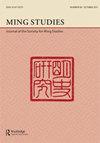The Eccentrics of Istanbul: Chan, Art, and Cross-Asian Networks in the Ming
IF 0.3
0 ASIAN STUDIES
引用次数: 0
Abstract
Images of Chan eccentrics were a popular artistic theme in East Asia from the eleventh century onwards. In the Ming dynasty (1368–1644), the theme was carried across the Eurasian continent to Persia. This article examines two fifteenth-century paintings of Chan eccentrics in Persian albums, currently in the Topkapi Palace Museum in Istanbul. It argues that the paintings are different both thematically and visually, and it explores them in the contexts of their specific albums and histories of collection and viewing. The article shows that each painting brings together visual and conceptual elements of many traditions, including Chinese, Persian and Eurasian traditions and Islamic mysticism. The paintings question common modes of art historical categorization. At the same time, they are evidence of lively artistic networks between Ming China and the Eurasian continent.伊斯坦布尔的怪人:陈、艺术与明代的跨亚洲网络
从11世纪开始,陈的怪癖形象在东亚成为一个流行的艺术主题。在明朝(1368-1644),这一主题被带过欧亚大陆到达波斯。这篇文章考察了波斯相册中两幅15世纪陈怪癖的画作,目前收藏在伊斯坦布尔的托普卡皮宫博物馆。它认为这些画在主题和视觉上都是不同的,并在它们的特定相册以及收藏和观看历史的背景下对它们进行了探索。文章表明,每幅画都融合了许多传统的视觉和概念元素,包括中国、波斯和欧亚传统以及伊斯兰神秘主义。这些画作质疑艺术历史分类的常见模式。同时,它们也是明代中国与欧亚大陆之间活跃的艺术网络的证据。
本文章由计算机程序翻译,如有差异,请以英文原文为准。
求助全文
约1分钟内获得全文
求助全文

 求助内容:
求助内容: 应助结果提醒方式:
应助结果提醒方式:


